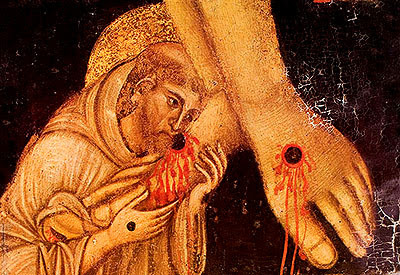The Mystic
We know St John by a number of titles: Apostle, Evangelist, the Beloved Disciple, 'the Divine'. Of all the apostles, he was the one closest to the Lord, the one who stood at the foot of the cross when the others had run away. John is often depicted as a young man in Christian iconography, perhaps even a teenager - this may have to do with the fact that he lived until about the year 100 AD, the last apostle to die, so he would have been quite young during the years of the Lord's ministry. Given the care of Our Lady, he is seen as her second son, and in the Gospel and Christian piety he is offered to us as the exemplary disciple, the one we should try to imitate. Jesus himself affirms this when, from the cross, he gives Our Lady to him as his mother: in this the Lord extended the motherhood of Mary to all Christians.
John's symbol as an evangelist is the eagle, and, in art, a chalice with a viper suspended above it. The latter refers to a legend that tells of an attempt to kill him with a poisoned chalice: John blessed the wine before drinking and the poison came out of the cup in the form of a viper. The eagle, taken from the vision of Ezekiel, refers to his Gospel. Different from the synoptic Gospels, it is more theological and seems to soar. It was believed that only the eagle could soar higher than other birds and fly in the face of the sun without being blinded; John, in his Gospel, soars to the heights. This may offer us another title for him, one which also becomes an exemplar for us: the Mystic.
Reading John's Gospel we cannot but be impressed by its theological depth. While the other Gospels are well written and carefully structured, John's is finely crafted, poetic, the fruit of much meditation. Having read the other Gospels which detailed the Lord's life, teaching and act of redemption very well, John could take another approach; he could build on their foundation and offer the Church a deeply contemplative work which includes stories and teachings the others did not include, but one which also seeks to share the very secrets John found in the Heart of Jesus himself.
There are many unique elements in the Gospel which speak of its singularity, but I think there are two moments which reveal what John is doing; both of these moments are, I believe, a single act though they occur about eighteen hours apart. These events reveal the mystical element of the Gospel and are an invitation to each one of us from the evangelist to seek to become mystics ourselves.
The first of these is that moment when John leans on the breast of the Lord at the Last Supper (Jn 13:23-26). Jesus had mentioned the presence of the betrayer, Peter wanted to find out who it was and asked John to do so - Jesus' relationship with John was so close that if anyone could get the information out of him, it was the beloved disciple. John leaned on the Lord's breast and asked him; Jesus told him, but, interestingly, it seems John did not pass on the information to Peter. That gesture of leaning on the Lord's breast has been taken by early Scripture scholars and spiritual writers as a moment when John was taken into the Heart of Christ, when the secrets of that Heart were revealed to him. It was a mystical moment.
If there is an image for the spiritual life, that of John on the Lord's breast, attentive to the beating of the Sacred Heart, is perhaps the best. We can see the steps of spiritual progress as climbing mountains, as we do in Carmel, but the journey into the Heart of Jesus, into the heart of God, is the most intimate and seems the less daunting. That is the spiritual life: to seek such intimacy with God, with Jesus, God incarnate, and to find our place there. John the mystic found refuge in that Heart, and as others ran away when things got difficult, he remained: the Heart of Jesus was his refuge and strength, he could weather any storm there.
That leads us to the second moment. Standing at the foot of cross beside Mary, having kept vigil as Jesus died, John witnesses the piercing of the Lord's heart (Jn 19: 34-35), and with it the fulfilment of the prophecies, the birth of the Church in the New Adam (born from his side, cf. Gen 2:21-23) and the outpouring of grace and redemption on the whole world. But he also witnesses the outpouring of the Heart of Christ onto the soul who seeks refuge in him. Blood and Water flow out, the foundation of sacramental grace, the soul is brought back to life, the mystic is born and vivified, he drinks from the well of the Saviour, sins are forgiven and he is transformed. John, the individual disciple, as he leans on the breast of the Lord is overwhelmed with the love and grace of Christ as that Heart opens and inundates the soul, intoxicates it, draws it into an intimate life, into union, mystical marriage.
This is Johannine mysticism and it permeates the whole Gospel and is the key to understanding it. It is reflected in notable episodes as the miracle of the wedding at Cana, the meeting with the woman at the well, the healing of the man at the pool of Bethesda, the discussions with Nicodemus and the call to enter into the light of the Lord's presence, the cry of the Lord for all to come and drink from the springs he offers. Jesus seeks to inspire his disciples to seek intimacy with him through his Bread of Life discourse, his speaking of himself as the Good Shepherd - do not be afraid to approach, he is the shepherd that protects. We see this in the resurrection accounts, where he encounters Mary Magdalene and tells her not to foster an old relationship but to seek a new intimacy; in the threefold forgiveness of Peter and the call to serve in a deeper way; in the gentle rebuke to Thomas which is in reality an invitation to enter his Heart even if it is with the curiosity of his quivering fingers first.
Many people fear John's Gospel, it is so theological, so finely crafted, tuned to perfection; and it is. However, as it is a Gospel to read with the mind to understand theological truths, it is also a Gospel to be read with the heart to understand the intimacy that Jesus wishes to have with us. John was a great theologian, but even better that than, he was a great lover, a mystic, and as he poured his theological genius into his work, he poured even more of his love, what he found in the Heart of Jesus after he had made it his home. He does so to inspire us to imitate him, to become beloved disciples ourselves. On his feast day, we have an opportunity to reflect on this and ask him to help us embrace the invitation of the Lord; indeed, embrace him and seek the mystical life in his Heart.




Comments
Post a Comment